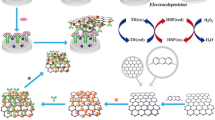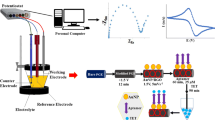Abstract
In this study, a simple label-free biosensor for Brucella was constructed, which based on the screen-printed carbon electrode (SPCE) modified by Recombinant protein G/gold nanoparticles/graphene oxide (RpG/Au/GO). The impedance responses of the proposed biosensor were measured by electrochemical AC impedance method in Brucella antigen gradient concentration solutions. The results showed that the linear range of this biosensor was from 1.6 × 102 CFU/mL to 1.6 × 108 CFU/mL with the minimum detection limit of 3.2 × 102 CFU/mL (S/N = 3). Moreover, the biosensor for Brucella detection possessed acceptable reproducibility with a relative standard deviation of 5.15% and acceptable stability with a relative standard deviation of 4.68%. The spiked recovery rate in actual pasteurized milk samples was more than 92%. Therefore, the developed biosensor exhibits excellent prospects in the selective quantification detection of Brucella abortus.






Similar content being viewed by others
Abbreviations
- SPCE:
-
Screen-printed carbon electrode
- RpG:
-
Recombinant protein G
- Au:
-
Gold nanoparticles
- GO:
-
Graphene oxide
- CV:
-
Cyclic voltammetry
- EIS:
-
Electrochemical impedance spectroscopy
- Rct:
-
Charge transfer resistance
- XRD:
-
X-ray diffraction
- SPR:
-
Surface Plasmon resonance
References
Bayramoglu G, Ozalp VC, Oztekin M, Arica MY (2019) Rapid and label-free detection of Brucella melitensis in milk and milk products using an aptasensor. Talanta 200:263–271. https://doi.org/10.1016/j.talanta.2019.03.048
Chammem H, Hafaid I, Bohli N, Garcia A, Meilhac O, Abdelghani A, Mora L (2015) A disposable electrochemical sensor based on protein G for high-density lipoprotein (HDL) detection. Talanta 144:466–473. https://doi.org/10.1016/j.talanta.2015.06.009
Chang YJ, Lee MC, Chien YC (2022) Quantitative determination of uric acid using paper-based biosensor modified with graphene oxide and 5-amino-1, 3, 4-thiadiazole-2-thiol. SLAS Technol 27(1):54–62
Chauhan P, Raja AN, Jain R (2020) Nanogold modified glassy carbon sensor for the quantification of phytoestrogenchlorogenic acid. Surf Interf 19:100536
Chen L, Tang Y, Wang K, Liu C, Luo S (2011) Direct electrodeposition of reduced graphene oxide on glassy carbon electrode and its electrochemical application. Electrochem Commun 13:133–137. https://doi.org/10.1016/j.elecom.2010.11.033
Chen H, Cui C, Ma X, Yang W, Zuo Y (2020) Amperometric biosensor for Brucella testing through molecular orientation technology in combination with signal amplification technology. ChemElectroChem. 7(12):2672–2679
Dca B, Fan DB, Xue ZB, Bq A, Xw B, Kz B (2022) A universal constructing method for high performance DNA biosensors based on the optimized photoelectrode material and dual recycling amplification. Appl Surf Sci 585:152661
De Lima LF, Pereira EA, Ferreira M (2020) Electrochemical sensor for propylparaben using hybrid Layer-by-Layer films composed of gold nanoparticles, poly (ethylene imine) and nickel (II) phthalocyanine tetrasulfonate. Sens Actuators, B Chem 310:127893. https://doi.org/10.1016/j.snb.2020.127893
Dk YENİ, Doğan A (2021) Evaluation of the analytical efficiency of Real-Time PCR in the diagnosis of Brucellosis in cattle and sheep. Kafkas Üniversitesi Veteriner Fakültesi Dergisi 27:503–509
Dong XX, Wang Y, Shen YD, Sun MY, Wang H, Lei HT, Xiao ZL, Yang JY, Xu ZL (2015) Nano material based novel electrochemical immunosensor and its application in the field of food safety. J Chinese Inst Food Sci Technol 15:136–146. https://doi.org/10.16429/j.1009-7848.2015.04.019
Gao J, Wang C, Chu Y, Han Y, Gao Y, Wang Y, Zhang Y (2022a) Graphene oxide-graphene Van der Waals heterostructure transistor biosensor for SARS-CoV-2 protein detection. Talanta 240:123197
Gao S, Guisán JM, Rocha-Martin J (2022b) Oriented immobilization of antibodies onto sensing platforms-A critical review. Anal Chim Acta 1189:338907
Guang-Feng W, Yan-Hong Z, Ling C, Lun W (2013) Applications of functional nanomaterials in electrochemical immunosensor. Chin J Analy Chem 41(4):608–615
Hezard T, Fajerwerg K, Evrard D, Collière V, Behra P, Gros P (2012) Gold nanoparticles electrodeposited on glassy carbon using cyclic voltammetry: Application to Hg (II) trace analysis. J Electroanal Chem 664:46–52. https://doi.org/10.1016/j.jelechem.2011.10.014
Huang S, Si Z, Li X, Zou J, Yao Y, Weng D (2016) A novel Au/r-GO/TNTs electrode for H2O2, O2 and nitrite detection. Sens Actuators, B Chem 234:264–272. https://doi.org/10.1016/j.snb.2016.04.167
Jafari-Kashi A, Rafiee-Pour HA, Shabani-Nooshabadi M (2022) A new strategy to design label-free electrochemical biosensor for ultrasensitive diagnosis of CYFRA 21–1 as a biomarker for detection of non-small cell lung cancer. Chemosphere 301:134636
Khan S, Ansari ZA, Alothman OY, Fouad H, Ansari SG (2017) Application of amine and copper doped magnesium oxide nanoparticles in electrochemical immunosensors for detecting Brucella abortus. Nanosci Nanotechnol Lett 9(11):1656–1664
Khan S, Ansari ZA, Seo HK, Ansari SG (2018) Synthesis and application of Cu-doped nickel and zirconium oxide nanoparticles as Brucella abortus electrochemical device development. Sens Lett 16(4):267–276
Li Y, Tang DP (2011) Graphene oxide- thionine and gold nanoparticles- functionalized amperometric biosensor for determination of glucose. J Fuzhou Univ (Natural Science Edition) 39:781–785
Liu S, Haller E, Horak J, Brandstetter M, Heuser T, Lämmerhofer M (2019) Protein A-and Protein G-gold nanoparticle bioconjugates as nano-immunoaffinity platform for human IgG depletion in plasma and antibody extraction from cell culture supernatant. Talanta 194:664–672. https://doi.org/10.1016/j.talanta.2018.10.079
Love JC, Estroff LA, Kriebel JK, Nuzzo RG, Whitesides GM (2005) Self-assembled monolayers of thiolates on metals as a form of nanotechnology. Chem Rev 105:1103–1170. https://doi.org/10.1021/cr0300789
Malathi S, Pakrudheen I, Kalkura SN, Webster TJ, Balasubramanian S (2022) Disposable biosensors based on metal nanoparticles. Sens Int 3:100169
Moon J, Byun J, Kim H, Jeong J, Lim EK, Jung J, Cho S, Cho WK, Kang T (2019) Surface-independent and oriented immobilization of antibody via one-step polydopamine/protein g coating: application to influenza virus immunoassay. Macromol Biosci 19(6):1800486
Pérez-Fernández B, de la Escosura Muñiz A (2022) Electrochemical biosensors based on nanomaterials for aflatoxins detection: a review (2015–2021). Anal Chim Acta 1212:339658
Robi DT, Gelalcha BD (2020) Epidemiological investigation of brucellosis in breeding female cattle under the traditional production system of Jimma zone in Ethiopia. Veterinary Animal Sci 9:100117. https://doi.org/10.1016/j.vas.2020.100117
Sabour S, Arzanlou M, Jeddi F, Azimi T, Hosseini-Asl S, Naghizadeh-Baghi A, Peeri Dogaheh H (2020) Evaluating the efficiency of TaqMan real-time PCR and serological methods in the detection of Brucella spp. in clinical specimens collected from suspected patients in Ardabil, Iran. J Microbiol Methods 175:105982
Satei E, Mirshahabi H, Zeighami H, Gholoobic A, Sadeghi H (2020) Molecular survey of BCSP31 and IS711 using PCR assays in detection of Brucella spp. in raw milk. Meta Gen 24:100683
Smith KCA, Oatley CW (1955) The scanning electron microscope and its fields of application. Bri J Appl Phys 6(11):391
Ulman A (1996) Formation and structure of self-assembled monolayers. Chem Rev 96(4):1533–1554. https://doi.org/10.1021/cr9502357
Wahab R, Khan ST, Ahmad J, Musarrat J, Al-Khedhairy AA (2017) Functionalization of anti-Brucella antibody on ZnO-NPs and their deposition on aluminum sheet towards developing a sensor for the detection of Brucella. Vacuum 146:592–598. https://doi.org/10.1016/j.vacuum.2017.01.019
Wang AJ, Zhu XY, Chen Y, Yuan PX, Luo X, Feng JJ (2019) A label-free electrochemical immunosensor based on rhombic dodecahedral Cu3Pt nanoframes with advanced oxygen reduction performance for highly sensitive alpha-fetoprotein detection. Sens Actuators B Chem 288:721–727
Wang Z, Yang S, Wang Y, Feng W, Li B, Jiao J, Han B, Chen Q (2020) A novel oriented immunosensor based on AuNPs-thionine-CMWCNTs and staphylococcal protein A for interleukin-6 analysis in complicated biological samples. Anal Chim Acta 1140:145–152. https://doi.org/10.1016/j.aca.2020.10.025
Wu H, Zuo Y, Cui C, Yang W, Ma H, Wang X (2013) Rapid quantitative detection of Brucella melitensis by a label-free impedance immunosensor based on a gold nanoparticle-modified screen-printed carbon electrode. Sensors. 13(7):8551–8563
Yin YY, Hou L, Zhang LL, Lin XB, Wu XP (2018) Electrochemical Immunosensor for Microcystin-LR Detection Based on Nano-composite Material Immobilization and Enzymatic Amplification. Chin J Anal Chem 46:493–501. https://doi.org/10.11895/j.issn.0253-3820.171055
Yin CX (2019) Preparation of electrochemical biosensors based on gold nanocomposites and their application, Qingdao University of Science and Technology.
Yuan YF (2014) A study of the characteristics of X-ray technology applications and their current development. J yan’an Vocational Tech Inst 28:123–124
Yuan Q, He J, Niu Y, Chen J, Zhao Y, Zhang Y, Yu C (2018) Sandwich-type biosensor for the detection of α2, 3-sialylated glycans based on fullerene-palladium-platinum alloy and 4-mercaptophenylboronic acid nanoparticle hybrids coupled with Au-methylene blue-MAL signal amplification. Biosens Bioelectro 102:321–327
Zhang SJ, Kang WJ, Niu LM (2019) Electrochemical behavior of dopamine at a biosensor based on a composite of gold nanoparticles and graphene, and its application in dopamine determination. Chem Res Appl. https://doi.org/10.3969/j.issn.1004-1656.2019.09.003
Zhang M, Ding Q, Zhu M, Yuan R, Yuan Y (2022) An ultrasensitive electrochemical biosensor with amplification of highly efficient triple catalytic hairpin assembly and tetris hybridization chain reaction. Sens Actuators, B Chem 361:131683
Zhao Z, Sun Y, Li P, Sang S, Zhang W, Hu J, Lian K (2014) A sensitive hydrazine electrochemical sensor based on zinc oxide nano-wires. J Electrochem Soc 161:B157. https://doi.org/10.1149/2.095406jes
Zhao G, Zhou B, Wang X, Shen J, Zhao B (2021) Detection of organophosphorus pesticides by nanogold/mercaptomethamidophos multi-residue electrochemical biosensor. Food Chem 354:129511
Acknowledgements
Thanks to Professor Yueming Zuo for language help in this article.
Funding
Our work has been supported by several organizations. We are sincerely grateful for the financial support from the Project of Youth Fund for Science and Technology Research in Hebei Universities (Grant number: QN2020194), the Project of Youth Fund for National Natural Science Foundation of China (Grant number: 32001791) and the National Natural Science Foundation of China (Grant number 30871445).
Author information
Authors and Affiliations
Corresponding author
Ethics declarations
Conflicts of interest
The authors declare no conflict of interest.
Ethics approval
Not applicable.
Additional information
Publisher's Note
Springer Nature remains neutral with regard to jurisdictional claims in published maps and institutional affiliations.
Supplementary Information
Below is the link to the electronic supplementary material.
Rights and permissions
About this article
Cite this article
Chen, H., Liu, H., Cui, C. et al. Recombinant protein G/Au nanoparticles/graphene oxide modified electrodes used as an electrochemical biosensor for Brucella Testing in milk. J Food Sci Technol 59, 4653–4662 (2022). https://doi.org/10.1007/s13197-022-05544-8
Revised:
Accepted:
Published:
Issue Date:
DOI: https://doi.org/10.1007/s13197-022-05544-8




